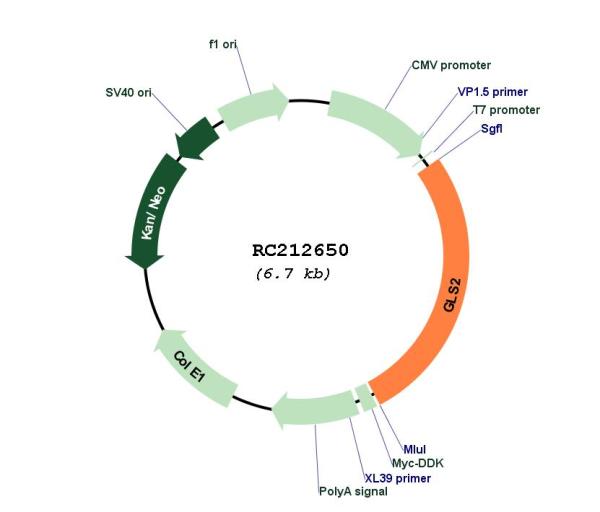GLS2 (NM_013267) Human Tagged ORF Clone
CAT#: RC212650
GLS2 (Myc-DDK-tagged)-Human glutaminase 2 (liver, mitochondrial) (GLS2), nuclear gene encoding mitochondrial protein
ORF Plasmid: tGFP
Lentiviral Particles: DDK DDK w/ Puro mGFP mGFP w/ Puro
"NM_013267" in other vectors (6)
USD 198.00
Specifications
| Product Data | |
| Type | Human Tagged ORF Clone |
| Tag | Myc-DDK |
| Symbol | GLS2 |
| Synonyms | GA; GLS; hLGA; LGA |
| Vector | pCMV6-Entry |
| E. coli Selection | Kanamycin (25 ug/mL) |
| Mammalian Cell Selection | Neomycin |
| Sequence Data |
>RC212650 representing NM_013267
Red=Cloning site Blue=ORF Green=Tags(s) TTTTGTAATACGACTCACTATAGGGCGGCCGGGAATTCGTCGACTGGATCCGGTACCGAGGAGATCTGCC GCCGCGATCGCC ATGCGCTCCATGAAGGCTCTGCAGAAGGCCCTGAGCCGGGCTGGCAGTCACTGCGGGCGAGGAGGCTGGG GTCACCCGAGCCGGAGCCCCCTCCTTGGCGGGGGCGTCCGGCACCACCTCAGTGAGGCCGCGGCGCAGGG CAGAGAGACGCCACACAGCCACCAGCCGCAGCACCAGGATCATGATTCATCAGAAAGTGGCATGCTGTCC CGCCTGGGTGATTTGCTCTTTTACACTATTGCTGAAGGACAGGAACGAATCCCTATCCACAAGTTCACCA CTGCACTAAAGGCCACTGGACTGCAGACATCAGATCCTCGGCTCCGAGACTGCATGAGCGAGATGCACCA CGTGGTCCAAGAGTCCAGTAGTGGTGGCCTCTTGGACCGAGATCTCTTCCGAAAGTGTGTGAGCAGCAAC ATTGTGCTCCTGACCCAGGCATTCCGAAAGAAGTTTGTCATTCCTGATTTTGAGGAGTTCACGGGCCATG TGGATCGCATCTTTGAGGATGTCAAAGAGCTCACTGGAGGCAAAGTGGCAGCCTACATCCCTCAGCTGGC CAAGTCAAACCCAGACCTGTGGGGTGTCTCCCTGTGCACTGTGGATGGTCAACGGCACTCTGTGGGCCAC ACAAAGATCCCCTTCTGCCTGCAGTCCTGTGTGAAGCCCCTCACCTATGCCATCTCCATAAGCACCCTAG GCACTGACTACGTGCACAAGTTTGTGGGCAAAGAGCCAAGTGGCCTGCGCTACAACAAGCTCTCCCTCAA TGAGGAAGGAATCCCCCATAACCCCATGGTCAATGCTGGTGCCATTGTTGTCAGCTCCCTGATCAAGATG GACTGTAACAAAGCAGAGAAGTTTGATTTTGTGTTGCAGTATCTCAACAAAATGGCTGGGAATGAATACA TGGGTTTCAGCAATGCCACATTCCAGTCAGAGAAGGAAACAGGGGATCGGAATTATGCCATCGGCTATTA TCTCAAGGAAAAGAAGTGCTTTCCTAAGGGGGTGGACATGATGGCTGCCCTTGATCTCTACTTCCAGCTG TGTTCTGTGGAGGTCACTTGTGAATCAGGCAGTGTCATGGCAGCCACCCTCGCCAACGGTGGGATCTGCC CCATCACAGGCGAGAGTGTGCTGAGTGCTGAAGCAGTGCGCAACACCCTCAGCCTCATGCATTCCTGCGG CATGTATGACTTCTCTGGCCAGTTTGCCTTCCACGTGGGCCTGCCAGCCAAGTCAGCTGTATCAGGAGCC ATCCTCCTGGTGGTACCCAATGTCATGGGAATGATGTGCCTGTCACCCCCATTGGACAAGCTGGGGAACA GCCATAGGGGGACCAGCTTCTGCCAGAAGTTGGTGTCTCTCTTCAATTTCCACAACTATGACAACCTGAG GCACTGTGCTCGGAAGTTAGACCCACGGCGTGAAGGGGCAGAAATTCGGAACAAGACTGTGGTCAACCTG TTATTTGCTGCCTATAGTGGCGATGTCTCAGCTCTTCGAAGGTTTGCCTTGTCAGCCATGGATATGGAAC AGAAAGACTATGACTCGCGCACAGCTCTGCATGTTGCTGCAGCTGAAGGACACATCGAAGTTGTTAAATT CCTGATCGAGGCTTGCAAAGTGAATCCTTTTGCCAAGGACAGGTGGGGCAACATTCCCCTGGATGATGCT GTGCAGTTCAACCATCTGGAGGTGGTCAAACTGCTTCAAGATTACCAGGACTCCTACACACTCTCTGAAA CTCAGGCTGAGGCAGCAGCTGAGGCCCTGTCCAAAGAGAACTTAGAAAGCATGGTA ACGCGTACGCGGCCGCTCGAGCAGAAACTCATCTCAGAAGAGGATCTGGCAGCAAATGATATCCTGGATT ACAAGGATGACGACGATAAGGTTTAA >RC212650 representing NM_013267
Red=Cloning site Green=Tags(s) MRSMKALQKALSRAGSHCGRGGWGHPSRSPLLGGGVRHHLSEAAAQGRETPHSHQPQHQDHDSSESGMLS RLGDLLFYTIAEGQERIPIHKFTTALKATGLQTSDPRLRDCMSEMHHVVQESSSGGLLDRDLFRKCVSSN IVLLTQAFRKKFVIPDFEEFTGHVDRIFEDVKELTGGKVAAYIPQLAKSNPDLWGVSLCTVDGQRHSVGH TKIPFCLQSCVKPLTYAISISTLGTDYVHKFVGKEPSGLRYNKLSLNEEGIPHNPMVNAGAIVVSSLIKM DCNKAEKFDFVLQYLNKMAGNEYMGFSNATFQSEKETGDRNYAIGYYLKEKKCFPKGVDMMAALDLYFQL CSVEVTCESGSVMAATLANGGICPITGESVLSAEAVRNTLSLMHSCGMYDFSGQFAFHVGLPAKSAVSGA ILLVVPNVMGMMCLSPPLDKLGNSHRGTSFCQKLVSLFNFHNYDNLRHCARKLDPRREGAEIRNKTVVNL LFAAYSGDVSALRRFALSAMDMEQKDYDSRTALHVAAAEGHIEVVKFLIEACKVNPFAKDRWGNIPLDDA VQFNHLEVVKLLQDYQDSYTLSETQAEAAAEALSKENLESMV TRTRPLEQKLISEEDLAANDILDYKDDDDKV |
| Chromatograms |
CHROMATOGRAMS
 Sequencher program is needed, download here. |
| Restriction Sites |
SgfI-MluI
Cloning Scheme for this gene
Plasmid Map

|
| ACCN | NM_013267 |
| ORF Size | 1806 bp |
| OTI Disclaimer | Due to the inherent nature of this plasmid, standard methods to replicate additional amounts of DNA in E. coli are highly likely to result in mutations and/or rearrangements. Therefore, OriGene does not guarantee the capability to replicate this plasmid DNA. Additional amounts of DNA can be purchased from OriGene with batch-specific, full-sequence verification at a reduced cost. Please contact our customer care team at custsupport@origene.com or by calling 301.340.3188 option 3 for pricing and delivery. The molecular sequence of this clone aligns with the gene accession number as a point of reference only. However, individual transcript sequences of the same gene can differ through naturally occurring variations (e.g. polymorphisms), each with its own valid existence. This clone is substantially in agreement with the reference, but a complete review of all prevailing variants is recommended prior to use. More info |
| OTI Annotation | This clone was engineered to express the complete ORF with an expression tag. Expression varies depending on the nature of the gene. |
| Product Components | The ORF clone is ion-exchange column purified and shipped in a 2D barcoded Matrix tube containing 10ug of transfection-ready, dried plasmid DNA (reconstitute with 100 ul of water). |
| Reconstitution | 1. Centrifuge at 5,000xg for 5min. 2. Carefully open the tube and add 100ul of sterile water to dissolve the DNA. 3. Close the tube and incubate for 10 minutes at room temperature. 4. Briefly vortex the tube and then do a quick spin (less than 5000xg) to concentrate the liquid at the bottom. 5. Store the suspended plasmid at -20°C. The DNA is stable for at least one year from date of shipping when stored at -20°C. |
| Reference Data | |
| RefSeq | NM_013267.4 |
| RefSeq Size | 2648 bp |
| RefSeq ORF | 1809 bp |
| Locus ID | 27165 |
| UniProt ID | Q9UI32 |
| Cytogenetics | 12q13.3 |
| Domains | ANK, Glutaminase |
| Protein Pathways | Alanine, aspartate and glutamate metabolism, Arginine and proline metabolism, D-Glutamine and D-glutamate metabolism, Metabolic pathways, Nitrogen metabolism |
| MW | 66.8 kDa |
| Gene Summary | The protein encoded by this gene is a mitochondrial phosphate-activated glutaminase that catalyzes the hydrolysis of glutamine to stoichiometric amounts of glutamate and ammonia. Originally thought to be liver-specific, this protein has been found in other tissues as well. Alternative splicing results in multiple transcript variants that encode different isoforms. [provided by RefSeq, Jul 2013] |
Documents
| Product Manuals |
| FAQs |
| SDS |
Resources
Other Versions
| SKU | Description | Size | Price |
|---|---|---|---|
| RC212650L1 | Lenti ORF clone of Human glutaminase 2 (liver, mitochondrial) (GLS2), nuclear gene encoding mitochondrial protein, Myc-DDK-tagged |
USD 1,140.00 |
|
| RC212650L2 | Lenti ORF clone of Human glutaminase 2 (liver, mitochondrial) (GLS2), nuclear gene encoding mitochondrial protein, mGFP tagged |
USD 1,140.00 |
|
| RC212650L3 | Lenti ORF clone of Human glutaminase 2 (liver, mitochondrial) (GLS2), nuclear gene encoding mitochondrial protein, Myc-DDK-tagged |
USD 1,140.00 |
|
| RC212650L4 | Lenti ORF clone of Human glutaminase 2 (liver, mitochondrial) (GLS2), nuclear gene encoding mitochondrial protein, mGFP tagged |
USD 1,140.00 |
|
| RG212650 | GLS2 (tGFP-tagged) - Human glutaminase 2 (liver, mitochondrial) (GLS2), nuclear gene encoding mitochondrial protein |
USD 1,040.00 |
|
| SC111793 | GLS2 (untagged)-Human glutaminase 2 (liver, mitochondrial) (GLS2), nuclear gene encoding mitochondrial protein |
USD 842.00 |
{0} Product Review(s)
Be the first one to submit a review






























































































































































































































































 Germany
Germany
 Japan
Japan
 United Kingdom
United Kingdom
 China
China





